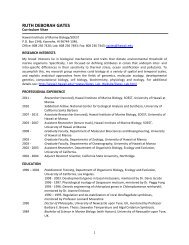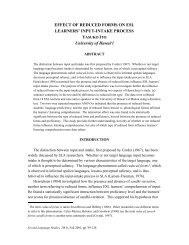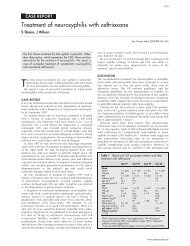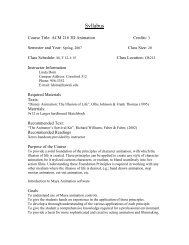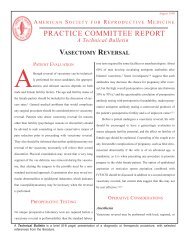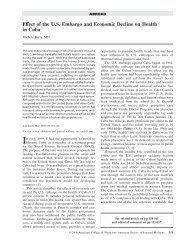Tying and Untying the Trouser-Cord - University of Hawaii
Tying and Untying the Trouser-Cord - University of Hawaii
Tying and Untying the Trouser-Cord - University of Hawaii
Create successful ePaper yourself
Turn your PDF publications into a flip-book with our unique Google optimized e-Paper software.
The Asia Pacific Journal <strong>of</strong> Anthropology 51<br />
were given a consecrated belt during <strong>the</strong>ir ritual affiliation. Among Muslim guilds<br />
<strong>and</strong> dervish fraternities, <strong>the</strong> novice puts on a belt, loincloth, or trousers during his<br />
initiation (Taeschner 1979; 3 Gramlich 1981, pp. 8 /11, 85 /7; cf. Nabhan 1994, pp. 70,<br />
75; Frembgen 1999, pp. 16 /18). They symbolise <strong>the</strong> extinction <strong>of</strong> desire in this life<br />
<strong>and</strong> are supposed to be guarded as an amanat, an article <strong>of</strong> property that is entrusted<br />
to one’s safekeeping <strong>and</strong> must be defended. Within <strong>the</strong> futuwwa corporations <strong>of</strong><br />
<strong>the</strong> Middle Ages, <strong>the</strong> wearing <strong>of</strong> trousers (sarawil al-futuwwa) <strong>and</strong> belt (shadd)<br />
were particularly important; in this context it is said that ‘<strong>the</strong> genitals, which are<br />
placed between navel <strong>and</strong> knee, should be covered’ <strong>and</strong> that ‘<strong>the</strong> strongest desire<br />
comes through <strong>the</strong> genitals’ (Taeschner 1979, pp. 162 /3, 246 /7, 334 /5). The tying <strong>of</strong><br />
<strong>the</strong> trousers is especially emphasised in order to protect oneself against committing<br />
adultery (zina). Likewise, <strong>the</strong> loincloth st<strong>and</strong>s out as part <strong>of</strong> <strong>the</strong> dress <strong>of</strong> <strong>the</strong><br />
Iranian Khaksar dervishes, an order explicitly called silsila-i lungb<strong>and</strong>an (lit. ‘chain <strong>of</strong><br />
<strong>the</strong> loincloth wearers’). The value <strong>of</strong> purity <strong>and</strong> consequently celibacy is similarly<br />
reflected in <strong>the</strong> importance <strong>of</strong> <strong>the</strong> loincloth (langoti, kaupina) as an essential<br />
symbol <strong>of</strong> ascetic identity in Hinduism. Indian sadhus <strong>and</strong> sannyasis wear loincloths<br />
made <strong>of</strong> cotton or <strong>of</strong> o<strong>the</strong>r vegetable fibres (Narayan 1989, p. 120). 4 They are<br />
described as ‘<strong>of</strong>ten just covering <strong>the</strong> penis <strong>and</strong> leaving <strong>the</strong> testicles exposed’ (Gross<br />
1979, p. 642), representing a kind <strong>of</strong> minimal clothing which underlines <strong>the</strong><br />
commitment to an ascetic life <strong>of</strong> renunciation. Likewise, a Muslim langotia faqir in<br />
<strong>the</strong> Punjab is somebody who has made a vow <strong>of</strong> celibacy never to remove his<br />
loincloth.<br />
As a means <strong>of</strong> ensuring morality through control <strong>of</strong> <strong>the</strong> body, belt <strong>and</strong> draped<br />
clo<strong>the</strong>s, such as loincloth or waistcloth, are not only important for mystics <strong>and</strong> holy<br />
men, but also for <strong>the</strong> common people. In North India, for instance, <strong>the</strong> colloquial<br />
expression langot b<strong>and</strong> (tightly bound loincloth) is used for a man <strong>of</strong> good character<br />
who controls his sexuality. Similarly, in Hindi langoti ka pakka hona means ‘to fasten<br />
<strong>the</strong> loincloth’, in <strong>the</strong> sense that it is done in a firm <strong>and</strong> solid (lit. ‘cooked’ <strong>and</strong> ‘baked’)<br />
way. Therefore, <strong>the</strong> South Asian langoti <strong>and</strong> <strong>the</strong> somewhat longer dhoti (Punj.<br />
tehmat) are wound around <strong>the</strong> waist with one end pulled through <strong>the</strong> legs <strong>and</strong> neatly<br />
tucked in at <strong>the</strong> back (Dar 1969, pp. 55, 58, 89 /90; Tarlo 1996, p. 26; Askari & Arthur<br />
1999, p. 74). The tightness <strong>of</strong> <strong>the</strong> tucking prevents <strong>the</strong> garment from falling<br />
down. The lungi or lacha is ano<strong>the</strong>r uncut (predominantly male) loincloth<br />
(sometimes made <strong>of</strong> silk) wrapped around <strong>the</strong> waist <strong>and</strong> <strong>the</strong>n tied by two or even<br />
three knots.<br />
Coming back to <strong>the</strong> belt, a few examples will suffice to show that, also even fur<strong>the</strong>r<br />
to <strong>the</strong> west in <strong>the</strong> Muslim world, sexual connotations are attached to this accessory.<br />
Among <strong>the</strong> Turks since earliest times, a high symbolic value was attributed to <strong>the</strong><br />
bridal belt. For example, on <strong>the</strong> occasion <strong>of</strong> marriage, <strong>the</strong> fa<strong>the</strong>r <strong>of</strong> <strong>the</strong> bride girdles<br />
his daughter with a special embroidered cloth belt (kizlik kemeri) <strong>and</strong> admonishes<br />
her not to disgrace <strong>the</strong> honour <strong>of</strong> her family. The belt, which is a token <strong>of</strong> <strong>the</strong> bride’s<br />
virginity, is a family heirloom h<strong>and</strong>ed down to <strong>the</strong> daughters from generation to<br />
generation. Among <strong>the</strong> Alevi-Turkmans in Turkey, <strong>the</strong> bride wears a sash decorated



